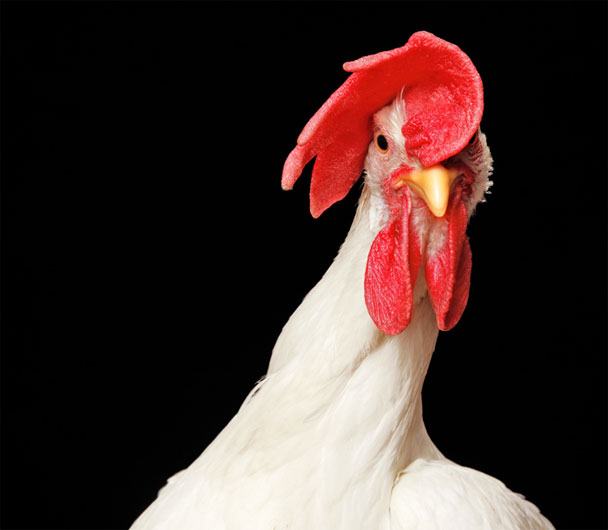
Chicken has become the hog of the meat case. Hold on, you pork lovers, I’m not dissing “the other white meat.” I’m talking about the huge portion of supermarket real estate devoted to whole chickens and parts in every possible state, dressed and undressed (read: skinless)—and I haven’t even mentioned ground meat. Let’s just admit it: Americans chow down on a lot of chicken—82.2 pounds per person in 2010! So here are 10 things you need to know about our favorite fowl. We’ll get the food safety stuff out of the way first, but don’t forget to scroll down for top quick-cooking tips.
1. DO NOT WASH YOUR CHICKEN
This will come as a shock to all of you who automatically rinse your poultry just before cooking. It certainly was for me. So what’s the big deal? Cross contamination! It’s the big bugaboo for the Food Safety and Inspection Service (FSIS), a division of the USDA. Rinsing your chicken is an ideal way to spew nasty pathogens all over your sink and the surrounding area. Consider even your dish rack, including the freshly washed utensils in it, contaminated if you give your chick a quick bath. Rinsing never did get rid of food-borne pathogens anyway, so why waste your time? The trick is to get your poultry onto the baking pan with the minimum amount of human contact, then wipe down your counters with hot soapy water. Better yet, follow the cleaning with a sanitizing solution of 1 tablespoon plain, old-fashioned liquid bleach in 1 gallon of water.
2. WOOD VERSUS PLASTIC CUTTING BOARD
There’s an ongoing controversy about the safety of wood versus plastic boards for cutting up raw chicken. The Food Safety Laboratory at UC Davis discovered that close-grained hardwood boards, even old and knife-nicked ones, were safe once scrubbed with soapy water, rinsed, and air-dried. New plastic boards were equally safe when cleaned by hand, but older plastic boards with knife scars had to be sanitized by running through a dishwasher.
3. WHY YOU MUST SCRUB HANDS
You can’t be reminded often enough: Wash your hands well and scrub under your nails. Have you noticed that chefs and serious cooks don’t have long nails? And they tend not to wear jewelry, either. Both provide great hiding places for bacteria. That mysterious stomach bug you had could very well have been a case of food poisoning from your own kitchen. We’re not at the point of needing Hazmat suits yet, but it’s wise to have a healthy respect for food-borne pathogens. Bacteria have been around a lot longer than we have, and they reproduce, mutate, and adapt to new situations far faster than we humans do.
4. THE MAGIC NUMBER
A lot of cooks still aren’t aware that the folks at the USDA dropped the recommended safe temperatures for all cooked poultry five years ago to a single minimum internal temperature: 165°F. The good news is that this results in juicy, tender meat. (The old temperatures were 180°F for a whole roast bird tested in the thigh, or 170°F for a breast. Both often result in dry-as-cotton meat.) The best way to know when your chicken has reached the magic number is an instant-read thermometer. The old cut-and-peek method does not work. “You really can’t tell by looking,” says Diane Van, Manager of the USDA Meat and Poultry Hotline, who suggests you may want to test your chicken in more than one spot. “I’ve cooked chicken breasts at home and stuck the thermometer in several places and gotten temperatures that range from 140°F to 165°F.” This is particularly important with a whole roast bird: Test both thighs and the thickest part of the breasts—some of the chickens these days sport boobs big enough to fill a double-D bra.
5. PICK CHICK FROM THE BACK
At the market, look for the most distant sell-by date. This means searching in the back of the stacks because the oldest chicken is usually stuck in front. Don’t be afraid to be a nuisance at the poultry case. (The re-stockers of the chicken shelves at my local market roll their eyes when they see me coming.) If you’ve got a long drive home or a bunch of errands to do, pick up the chicken last, and pack it in a cooler with ice packs. On a cool day, raw chicken shouldn’t be unrefrigerated for longer than two hours; on a warm day, no more than one hour.
6. DON’T LET IT HANG AROUND
Despite these precautions, cook your chicken within two days of buying it. Home fridges are warmer than the ones in stores (which can go as low as 26°F), and tend to be opened often. This explains why I’ve had to toss out so much raw chicken. If the sell-by date was way in the future, I always figured I had several days’ leeway. Invariably, though, by the time I got around to it, I’d open the package to that telltale, hold-your-nose, the-chicken’s-gone-off aroma. Out to the garbage it would go, and then I’d scramble to figure out something else for dinner. Sound familiar?
7. LOVE YOUR GIBLETS (WORLD’S EASIEST PÂTÉ!) Think of the giblet package lurking inside a whole chicken (containing neck, giblet, heart, and liver) as your very own “goodie bag.” I freeze the livers in a separate heavy-duty plastic bag, and when I’ve amassed 1/4 pound (about 3 large livers), I make a quick pâté/spread for a simple hors d’oeuvre for 4 people:
Chicken Liver Pâté
Thaw the livers in the fridge the day before, then drain and pat dry. Trim any green spots or connective tissue. Cook 1/2 medium onion and 1 large garlic clove, both finely chopped, with 1/4 teaspoon salt and a generous pinch of both dried thyme and ground allspice (or clove) in 3 tablespoons unsalted butter in a heavy medium skillet over medium heat, stirring, until softened, about 4 minutes. Add livers, and about 6 grinds of fresh black pepper and cook, stirring, until livers are brown on outside but pale pink within—cut a couple open—3 to 4 minutes. Add 2 tablespoons brandy or bourbon, let it boil about 15 seconds, and remove from heat. Scrape everything into a food processor and puree well, then season with salt and pepper. Spread it in a crock or bowl, and serve warm, or chill it, covering the surface with wax paper and the container with plastic wrap. To serve: Surround pâté with baguette toasts or crackers and have ready some flaky (Maldon) sea salt for that final flourish.
8. GET THE STOCK HABIT
Once this is ingrained into your routine, you’ll wonder why you didn’t start a long time ago. All you need do is collect and freeze carcasses from any roast chickens (even supermarket rotisserie birds), plus any fresh skin and bones you might have. Also freeze the necks, gizzards, and hearts from the giblet packages, and if you see chicken feet, backs, or necks for sale in the market, grab them. The feet, in particular, make a fabulously rich, gelatinous stock.
When you’ve got a decent pile of scraps, parts, skin, and bones, dump them in a pot with a carrot, a celery rib, and a halved onion (the French like to stick a whole clove in one of the onion halves) and cover everything with water. Bring it to a boil and skim the froth. At this point you can add a couple of parsley sprigs with stems and a bay leaf, but it’s not essential. Simmer it, uncovered, for three hours—and don’t feel tied to the kitchen; just check on it occasionally and keep the bones covered with liquid. If you want to save time, a pressure cooker will give you a marvelous stock in less than an hour. A slow cooker will do the work overnight so that you wake up to the comforting aroma of real chicken broth.
When it’s done, skim most of the fat and cool the stock down quickly in an ice bath, then chill it. A great trick is to freeze it in ice cube trays and then pop out the frozen blocks of stock and keep them in a bag in the freezer to use when making a quick pan sauce. I use up most of my stock in risotto. I just can’t bear to spend money on something that’s not only easy to make but also tastes so much better than anything you can buy.
9. BE SCHMALTZY
The fat police want us to skim and snip every bit of fat from our meat and stocks, but chicken fat (when rendered it’s known as schmaltz in German and Jewish kitchens) has some winning qualities. It is high in palmitoleic acid, which is thought to be an immune booster, and it can also be a source of oleic acid, which is a good thing for cholesterol. Also, poultry fats are low in polyunsaturated fatty acids, making them more stable than other fats at higher heat. One of the secrets to why real Jewish chopped liver is so delicious is the schmaltz the onions and liver are sautéed in.
10. STEAL THE CHEFS’ SECRET
Isn’t crisp skin and tender, juicy meat what we most yearn for in chicken? But how to reach that double-whammy nirvana? High-heat roasting doesn’t always result in perfect skin, and broiling can dry out the meat. Here’s a chef tip: Pan-roast your chicken.
First, heat your oven to 425°F. For this method, pat the skin side dry (the USDA isn’t keen, but you’ll have fewer splatters) and immediately dispose of the paper towels, then season well with good salt and pepper. On top of the stove, heat a heavy ovenproof skillet (preferably cast-iron) until it’s really hot, and film the bottom lightly with oil. Add your chicken pieces, skin side down, without crowding, and brown the skin well—do this in batches, if necessary. Turn the chicken skin-side up (it’s OK to crowd the skillet a bit now), then transfer the skillet to the oven and roast it until it registers 165°F on an instant-read thermometer: 20 to 25 minutes for breasts on the bone and 25 to 30 minutes for drumsticks and thighs. Be sure to use a good oven mitt when removing the skillet from the oven!
Kemp Minifie was wrapped up in all aspects of food at Gourmet magazine for 32 years, and is now part of the Gourmet Live team. For more tried and tested tips and tricks, check out her weekly Kemp’s Kitchen column on the Gourmet Live blog.

